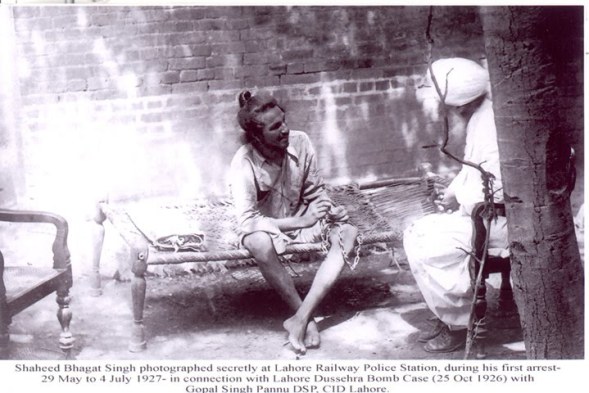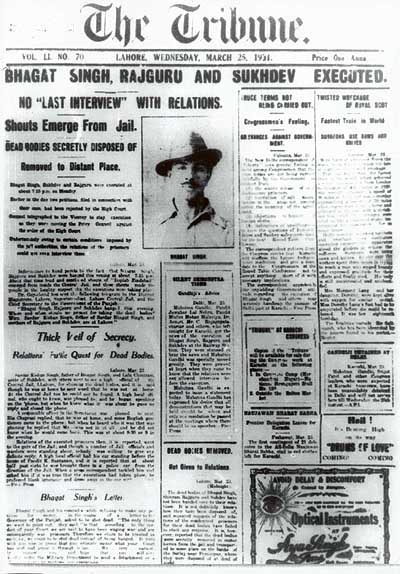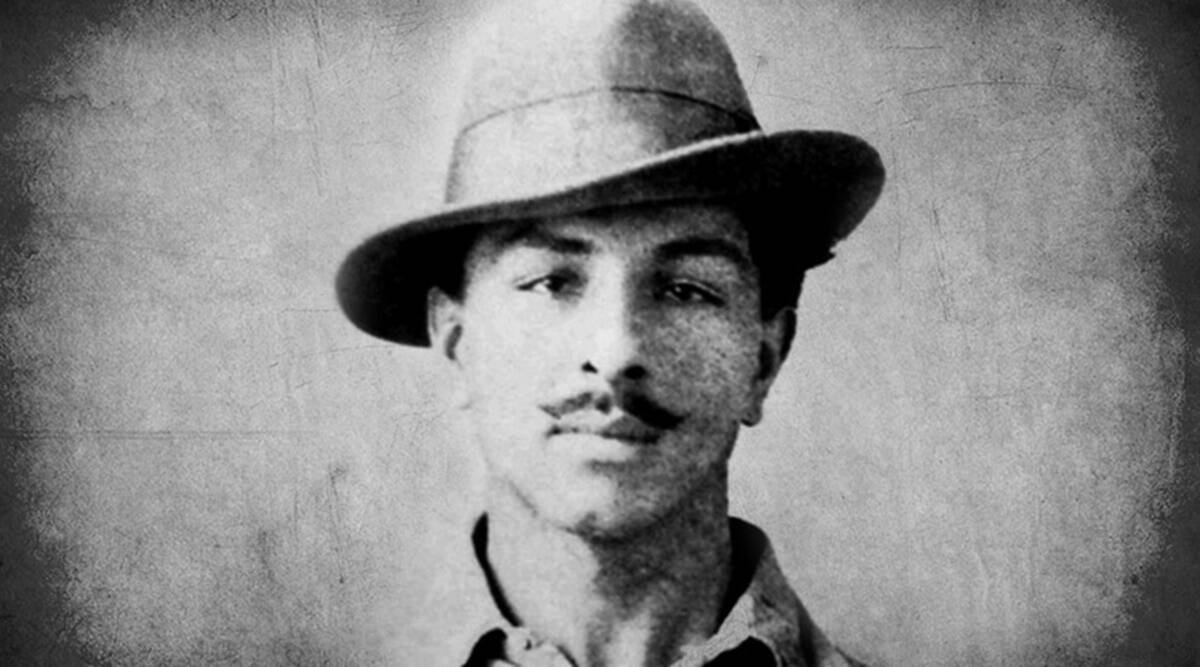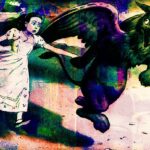In this article, we will be discussing Shaheed Bhagat Singh and his trial and execution. Shaheed Bhagat Singh was an Indian independence activist who was considered to be one of the most influential revolutionaries of his time.
He was born in British India and later became a part of the Hindustan Socialist Republican Association. Bhagat Singh was arrested and tried for his involvement in the murder of a British police officer in Lahore in 1928.
April 8, 1929.
The Assembly at Delhi was in full session. Two young men, both belonging to the Hindustan Republican Socialist Association, walked into the Assembly and threw two bombs toward the seats occupied by Government officials.
The bombs were not made to cause any real damage. There were no injuries to anyone except some minor scratches. However, it caused some commotion as the men rushed out of the room in mortal fear for their life. Some like Nehru, and Madan Mohan Malaviya stood there, calm, not really taken aback too much.
And amidst the chaos and melee, stood two men, calm, composed, and collected, staring defiantly.
The two young men were Bhagat Singh and Batukeshwar Dutt. [*]
Bhagat Singh, a man who was an icon of sorts in the revolutionary spectrum of India’s freedom movement. A man who smilingly went to the gallows, whose only purpose in throwing the bomb was to make the deaf hear.
A young man, who did not fear death, and for whom violence was only a last resort to make people take their notice. Books have been written about him, movies have been made about his life, and to many an idealist, he has been an aspirational figure.
Even on this occasion, the reason Bhagat Singh along with Dutt threw the bombs in the Assembly, was to protest against a bill that sought to stop labor agitations. Bhagat Singh along with Dutt had been going to the Provisional Assembly for the last 3-4 days, doing a recce of the place.
Both men were armed with fully loaded revolvers. If they wanted, they could have as well shot the officers and escaped. But both of them calmly laid down their weapons and surrendered to the police, raising slogans of “Inquilaab Zindabad” (Long Live the Revolution). And they threw pamphlets of the Hindustan Republican Socialist Association, quoting the French anarchist Valiant “It takes a loud voice to make the deaf hear”.
The backdrop to this event was the massive strike by the mill workers of Mumbai, against the working conditions and owners. The Hindustan Socialist Republican Association (HSRA), saw this as a historical opportunity to identify with the labor and peasant movements.
The Congress then was typically a party of the bourgeois and the elite, the HSRA, on the other hand, identified itself with the youth, the workers, and peasants. The Government had gone after many socialist leaders following the strike in Mumbai and was planning to bring in the Trade Disputes Bill, which was primarily a draconian measure that sought to ban trade unions.
Bhagat Singh and Batukeshwar Dutt wanted to make their voice heard loud and clear, and that was the reason behind throwing the bombs. In the words of Hansraj Vora, who later became an approver in the Lahore Conspiracy case:
According to Sukhdev, the object of throwing bombs in the Assembly was that they might be able to show their ‘protest’ against the unjustifiable provisions of the Trades Dispute Bill and the Public Safety Bill. But they had no intention of killing anybody. The bombs were deliberately kept weak so that even if their explosion did some harm to the Government benches, no harm might come to the Congress leaders.
Bhagat Singh along with Dutt wanted to put across their viewpoint in the Court, the reason why they willingly surrendered to the police. Actually much before they made their statement in the Court of Sessions, copies of it were sent to all newspapers in India and even outside India like Pravda of Russia and La Humanite of Paris.
The Nau Jawan Bharat Sabha which was founded by Bhagat Singh himself did the publicity work for the Assembly Bomb outrage case. The statement was distributed all over India, and short biographies of Bhagat Singh along with Dutt were circulated to all leading newspapers, which they gladly published.
The intention of propagating the goals of HSRA was fulfilled, it came into prominence and the imagination of the youth was roused.

The Hunger Strike
There was a reason why Bhagat Singh went on a hunger strike for the prisoners before the Sessions Court started the trial. The reason was that he wanted to make the public aware of their terrible plight. The prison conditions were appalling, and even that is an understatement. Prisoners either turned mad or died in captivity.
Most prisoners were kept in solitary confinement away from other prisoners to break their spirits and to avoid outbreaks. While Bhagat Singh received somewhat better treatment, he was well aware of the harsh conditions under which most prisoners labored. He had nothing to gain personally from launching a hunger strike, he knew that sooner or later, he would be prosecuted for the murder of Saunders, come what may.
Bhagat’s demand was that all political prisoners should be allowed facilities for reading, newspapers, better light, and a better diet. He did not seek an idealistic treatment, what he asked for were the basic necessities to prisoners, which was practicable and could be worked out.
The authorities initially dismissed Bhagat Singh’s fast, feeling he would not be able to withstand the rigors. However when Jatin Das, joined in the fast unto death, it spread among the under-trials too, and soon the strike in Lahore became news all over the nation.
The Punjab Government was forced to accede to some of the demands, for instance giving medical facilities to some of the under-trials. Jatin Das meanwhile went into a critical stage following his fast unto death, and it was only Bhagat Singh’s intervention that made him break the fast temporarily.
He was too weak however by that time. With the authorities refusing to release Jatin Das, the hunger strike continued, along with Bhagat Singh, Dutt, and others. Sadly it had no effect, and Jatin Das died fasting in the prison. With Jatin Da’s death, Bhagat Singh and his comrades had to give up on the hunger strike.
Lahore Conspiracy Case Trial
With the trial about to begin, Bhagat Singh along with Sukhdev and Bijoy Kumar Sinha formed a small group that would serve to propagate their ideas during the trial. They first made persistent efforts to improve the rights of the under-trials through their demands and were able to extract honorable treatment from authorities.
Chairs, newspapers, and tables were provided to under-trials and they were recognized as political prisoners. Bhagat Singh along with others also managed to secure the rights of people to visit the under-trials regularly at Lahore Central Jail, and this was to ensure that the public would be impacted by the proceedings.
The under-trials themselves cross-examined the witnesses, including some of the approvers. This again was done more in the need to propagate the party ideals, their motives, and their struggle to the public. Bhagat Singh very well knew the verdict would be against him, for him the trial was only a platform to spread his ideology and awaken the masses.
The under-trials never missed an opportunity to demonstrate on some occasion or other be it Lala Lajpat Rai’s death anniversary or the First of May or the anniversary of the Kakori conspiracy, the main intent was to send the message to the public in whatever way they could.
At one stage, Bhagat Singh demanded that the under-trials should not be handcuffed while in the trial, and come what may they would never attend court with handcuffs. Of the 16 under-trials, only 5 could be managed to be brought to the court, and that too with some great difficulty.
Specially trained Pathans were used to mercilessly beat the under-trials, and Bhagat Singh himself was singled out for the worst treatment. 8 Pathans fell on Bhagat Singh and beat him up in full view of the public. This incident had the desired effect. The public outrage against the treatment of Bhagat Singh hit a fever pitch, and massive demonstrations occurred. And soon the court authorities realizing that Bhagat and his comrades would rather die than be bought to prison in handcuffs, revoked the orders.
The under-trials caught the imagination of the world now. A lady from Poland donated money. People from Japan, Canada, and even Latin America began to donate to the cause. Bhagat Singh and Dutt became heroes. Their portraits were used in calendars all across the nation. Netaji Subash Chandra Bose, Moti Lal Nehru, and Baba Gurudutt Singh were among the nationalist leaders who visited the under-trials in prison.
Faced with growing resentment and ever-increasing support for Bhagat Singh and his comrades, the Government ultimately came up with the Lahore Conspiracy Case Ordinance and promulgated it in 1930. This only brought in more sympathy for Bhagat Singh and others from the public, now being seen as the victims of an unjust and unfair trial.
Bhagat Singh now proposed that the under-trials should refuse to accept the court proceedings, but one group felt it was necessary to make a statement in the court. However, when Bhagat Singh and his comrades were again handcuffed in court, after raising revolutionary slogans, the other group too did not see the point in attending the court. The Government tried its best to bring the under-trials to court but failed and so the proceedings were conducted ex-parte.
The Judgement
On the morning of Oct 7, 1930, a special messenger came to jail from the Special Tribunal court, carrying the execution orders of Bhagat Singh, Sukhdev Thapar, and Rajguru. The day of the execution was not announced, and special armed forces were stationed around to prevent an emergency-like situation.
Massive protests broke out all over India on the verdict, meetings were held slamming the ex-parte trial and the harsh sentences. Lahore erupted in fury, the Lahore Students Union called for a complete hartal, and educational institutions were boycotted. A professor and 80 students in Lahore’s DAV College were lathi-charged.

The protesters raised slogans praising Bhagat Singh, Sukhdev, and Rajguru, and a resolution was passed in Bradlaugh Hall congratulating the 3 men for their sacrifice. Lala Lajpat Rai’s daughter Smt. Parvati Devi organized another demonstration outside Morigate in Lahore.
Protests broke out all over Punjab and hartal was observed in many places. From Delhi to Mumbai, from Kolkata to Kanpur, and from Allahabad to Varanasi, meetings were organized in support of Bhagat Singh. A special Defence Committee decided to file an appeal in the Privy Council for the promulgation of an ordinance on ultra vires ground.
This Committee was formed way back in 1929, to collect money for the under-trials and to also help the families of the accused. The Committee also arranged to supply books to the under-trials and help the relatives and visitors with boarding and lodging.
The reason for appealing to the Privy Council was to draw the attention of the world to the inhumane treatment of political prisoners in India, and also the martyrdom of Jatin Das. Another was to make the world aware of a revolutionary socialist party in India, especially England’s enemies.
Also, Bhagat Singh was aware that the Congress might come up with some kind of sham settlement with the Govt, so he wanted enough time to drag, and the Govt could hang him at such a juncture, which would strengthen the extremist section of the party while dealing a blow to the credibility of the moderates.
March 23, 1931
Following the failure of the Privy Council, a movement started to get the sentences of Bhagat Singh, Sukhdev and Rajguru commuted to life imprisonment. Mahatma Gandhi did make an appeal to save them from hanging, but he was not in favor of their methods. In his own words
Hence, though we praise the courage of these brave men, we should never countenance their activities. Our dharma is to swallow our anger, abide by the discipline of non-violence, and carry out our duty.
Youngsters led demonstrations in support of Bhagat Singh, Sukhdev, and Rajguru and against the hangings. Even in England, the sentence evoked widespread criticism, and even the Viceroy too was not much in favor of it.
However, the Congress party suspended the agitation all of a sudden. It was nothing short of surrender. And finally, on March 23, 1931, the 3 men were scheduled to hang from the gallows. Bhagat Singh was reading the biography of Lenin on his last day, a revolutionary who was his ideal, and then along with Sukhdev, Rajguru walked to the gallows with a smile on his face.
And to the English Dy. Commissioner who was there to witness the executions, he said with a smile,
Well Mr. Magistrate, you are fortunate to be able to see how Indian revolutionaries can embrace death with pleasure for the sake of their supreme ideal.
And on March 23, 1931, at 7:33 PM the cries of Inquilaab Zindabad, Bhagat Singh, Sukhdev, and Rajguru were hanged. Nay, the 3 brave men, gave their lives smilingly for India’s freedom, they had exposed the corruption and tyranny of British rule, and they had managed to make the deaf hear and rouse a nation.
As Netaji Subash Chandra Bose had put it “He had become the symbol of awakening among youths”. And Nehru who did not support Bhagat Singh’s ideas and methods paid his tribute too:
He was a clean fighter who faced his enemy in the open field … he was like a spark that became a flame in a short time and spread from one end of the country to the other dispelling the prevailing darkness everywhere.
Note: There might be a few things that are factually not accurate or do not align with other opinions, feel free to comment on your views to improve this content.
Read More –




